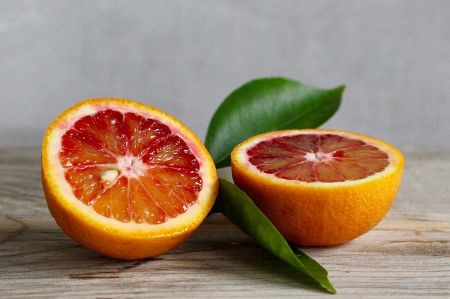Oranges and blood oranges – vitamins in winter
- Written by Portal Editor
Who doesn't appreciate the delicious oranges, fruits of the tree that originally comes from China or Southeast Asia, where they were once created from a cross between mandarin and grapefruit.
The orange was not found in Europe before the 15th century - in contrast to the similar bitter orange, which had already reached Europe overland in the Middle Ages.
Vasco da Gama reported good oranges as early as 1498
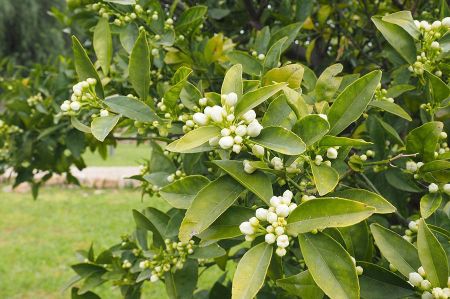 Even if there is some evidence of sweet oranges from an earlier date, the quality only seems to have increased significantly from 1500 onwards due to the introduction of better varieties by the Portuguese, who spread them throughout Europe after the discovery of the sea route to India. Vasco da Gama reported in 1498 that he had seen very good oranges in Mombasa, much better than those known in Portugal at that time. The connection between sweet oranges and Portugal, which is reflected in the naming in several languages, may have been promoted by the story that the one, original and originally introduced tree still stood in Lisbon for centuries.
Even if there is some evidence of sweet oranges from an earlier date, the quality only seems to have increased significantly from 1500 onwards due to the introduction of better varieties by the Portuguese, who spread them throughout Europe after the discovery of the sea route to India. Vasco da Gama reported in 1498 that he had seen very good oranges in Mombasa, much better than those known in Portugal at that time. The connection between sweet oranges and Portugal, which is reflected in the naming in several languages, may have been promoted by the story that the one, original and originally introduced tree still stood in Lisbon for centuries.
Oranges, north of the so-called Speyer Line also known as the orange, which is particularly popular in the cold, humid season as an additional source of important vitamins. The Speyer Line, one may forgive us for the short digression, is also referred to as the appel/apfel line (“Äppelequator” in the Spessart) and the Main Line (the isogloss crosses the Main several times at Faulbach, Freudenberg (Baden) and Großheubach), For a long time in modern German studies represented the isogloss within the West Germanic dialect continuum that, according to Georg Wenker and Ferdinand Wrede, separated the Upper German dialects from the Central German ones. But now quickly back to the fruit.
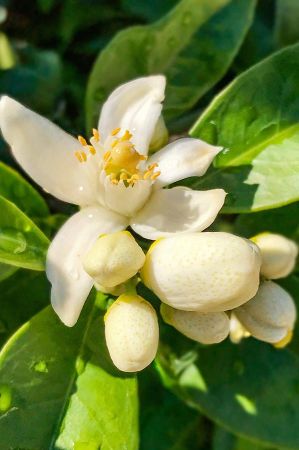 Like other citrus fruits, the orange is a good source of vitamin C, B vitamins and folic acid as well as minerals such as potassium and calcium. It is best not to store the fruits in the fruit basket, but rather in a pantry or in the cellar. Stored in a cool, airy place they will last for one to two weeks. In regions with tropical, warm nights and high humidity, the fruits remain green during ripening.
Like other citrus fruits, the orange is a good source of vitamin C, B vitamins and folic acid as well as minerals such as potassium and calcium. It is best not to store the fruits in the fruit basket, but rather in a pantry or in the cellar. Stored in a cool, airy place they will last for one to two weeks. In regions with tropical, warm nights and high humidity, the fruits remain green during ripening.
The colour orange is therefore not a sign of maturity! Because many consumers consider the green colour to be a sign of immaturity, the green fruits are usually degreened before sale by exposing them to ethylene gas, which destroys the green chlorophyll in the peel. The resulting loss of quality is accepted for the sake of better marketing.
The blood orange is a special orange.
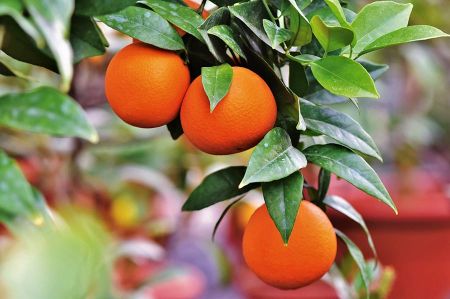 Blood oranges are characterized by a deep red coloured flesh with a tart-spicy to sweet-sour berry aroma. The fruits are still in season until the end of March. But how does blood orange get its dark red colour?
Blood oranges are characterized by a deep red coloured flesh with a tart-spicy to sweet-sour berry aroma. The fruits are still in season until the end of March. But how does blood orange get its dark red colour?
The blood orange is grown in the Mediterranean, especially in Sicily. The well-known “Moro” variety comes from the fertile slopes of the Etna volcano in the southeast of the island. The blood orange needs cold nights and warm days for the rich red colour of the juice, pulp and, depending on the variety, also the peel. When it is fifteen to twenty degrees Celsius during the day and the temperatures drop to two to zero degrees Celsius at night, anthocyanins are formed. These are secondary plant substances that are said to have a cell-protecting and anti-inflammatory effect. The dyes are deposited and ensure the rich red.
Blood oranges are usually eaten pure or pressed into juice. The fruits also taste good in fruit salads, smoothies, tarts, fruit cakes, sorbets and desserts. Spicy foods such as leaf salads, soups, poultry and fish dishes also get more zest with citrus fruits.
That's why blood oranges are the better oranges
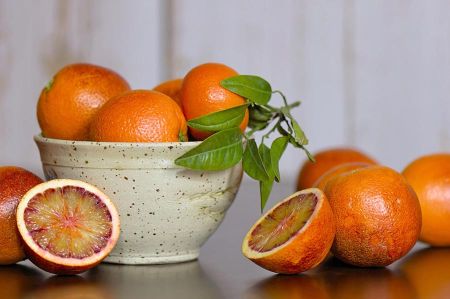 Blood oranges have partially or entirely deep red flesh. This means they taste a little stronger and contain more secondary plant substances - anthocyanins. The temperature fluctuations between day and night ensure that the flesh and sometimes the peel turn blood red. This applies at least to the so-called full-blooded oranges such as Moro or Sanguinello. Tarocco, on the other hand, is a half-blood orange. Their flesh is not consistently dark in colour, the peel remains orange.
Blood oranges have partially or entirely deep red flesh. This means they taste a little stronger and contain more secondary plant substances - anthocyanins. The temperature fluctuations between day and night ensure that the flesh and sometimes the peel turn blood red. This applies at least to the so-called full-blooded oranges such as Moro or Sanguinello. Tarocco, on the other hand, is a half-blood orange. Their flesh is not consistently dark in colour, the peel remains orange.
Blood oranges are in season from January to March. Especially at the beginning of the year, the typical colouring is not always present. Then there weren't enough warm days and cold nights, so the tarocco in particular looks like a normal orange - just a little smaller.
Blood oranges are packed with important nutrients
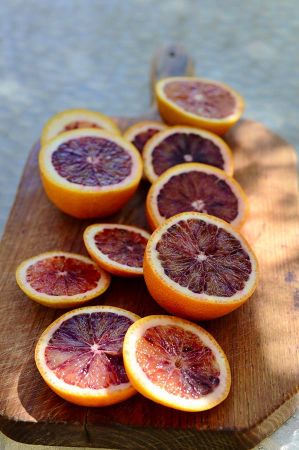 Blood oranges taste particularly aromatic. Its flesh impresses with its slightly tart, wonderfully spicy aroma, which tastes sweet and sour like berries. Blood oranges basically have the same great ingredients as oranges.
Blood oranges taste particularly aromatic. Its flesh impresses with its slightly tart, wonderfully spicy aroma, which tastes sweet and sour like berries. Blood oranges basically have the same great ingredients as oranges.
They not only provide plenty of vitamin C, but also B vitamins and folic acid as well as minerals such as potassium and calcium. Also noteworthy is the fiber-rich white part of their shell, the so-called mesocarp. This should not be carefully drained, but rather eaten in abundance.
Blood oranges also contain the anthocyanins already mentioned.
They give the fruit its deep red colour and particularly aromatic taste.
Anthocyanins - valuable secondary plant substances
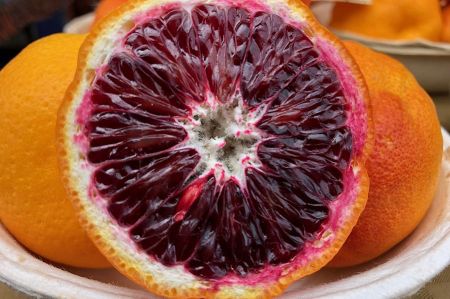 Anthocyanins are secondary plant substances, more precisely flavonoids. These water-soluble dyes are found in many red, blue and purple vegetables and fruits. The colour depends on the respective pH value.
Anthocyanins are secondary plant substances, more precisely flavonoids. These water-soluble dyes are found in many red, blue and purple vegetables and fruits. The colour depends on the respective pH value.
Anthocyanins have an antioxidant effect, so they can protect our cells from aging and becoming sick - at least a little. They also have an anti-inflammatory and vascular protective effect.
However, they are poorly bioavailable. This means that our body can only absorb up to three percent of the dye. It is therefore still unclear to this day how much good anthocyanins can actually do in our organism, or whether an interaction with other substances in the fruits may improve their effectiveness. The fact is that anthocyanins, which appear reddish to blue, are found in many types of fruit and vegetables. And we shouldn't miss it.
Please read as well:
